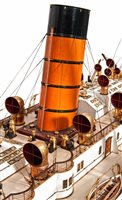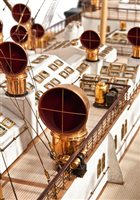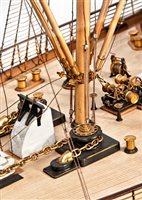12th May, 2015 12:00
Maritime and Scientific Models, Instruments & Art (Sandwich)
379
[M] A 1:64 SCALE BUILDER'S MODEL FOR THE FAMED...
A 1:64 SCALE BUILDER'S MODEL FOR THE FAMED 'NORTH ATLANTIC GREYHOUND' MAURETANIA, BUILT FOR CUNARD BY SWAN HUNTER & WIGHAM RICHARDSON, TYNE AND WEAR, 1906
carved from laminated wood, replete with gilt and painted fittings and superstructure and finished in Cunard service livery, mounted on seven turned balustrade supports on later display base within modern two-part case supported on three ebonised plinths. Model measurements -- 42 x 153½ x 17in. (106.5 x 390 x 43cm.); Cased measurements overall -- 79 x 173½ x 24in. (200.5 x 440 x 61cm.)
Provenance: Loaned by Swan Hunter to the Science Museum, London 1938-2015, Ref No. 1938-507.
This model is available for viewing from mid-March, 2015 at the DoubleTree by Hilton Hotel, Chelsea, Imperial Road, Imperial Wharf, SW6 2GA - please see map inside back cover.
Charles Miller Ltd is grateful for their kind assistance.
It is thought that this model probably appeared in a pre-War exhibition about the famed 'Blue Riband' but was then dismantled for the duration of hostilities. After the War, the ageing 1864 museum buildings were largely rebuilt and the fine collection of both ship and engineering models it had inherited from the old South Kensington Museum (which in turn had inherited them from the Royal Institution of Naval Architects) returned in the 1963 installation of the Shipping Gallery. It seems likely that it was at this time that the models were removed from their original cases and placed on uniform plinths within more standard exhibition cases. The Shipping Gallery was closed in 2012, having lasted fully forty-nine years, and the models removed to various storage facilities in London and Wiltshire. The precise fate of the original ship model cases, bases and plates appears not to have been recorded and, sadly, the one which had housed this particular model has still not been located and must therefore be presumed destroyed. A companion model to this lot, which retains its original carved mahogany case, display base and builder's plates, can be seen in the Discovery Museum, Newcastle to where it was likewise loaned by Swan Hunter in 1938.
Of all the great liners that plied the North Atlantic, the first-named Mauretania was perhaps the most famous. Conceived with her sister Lusitania, the two ships were built as a British response to the increasing threat to Cunard's domination of the transatlantic passenger trade posed by the White Star Line which, in 1901, had passed into American ownership. Mauretania, at 31,938 tons, was launched on 20th September 1906, and was ready for trials exactly a year later. Her builders, Swan Hunter, handed her over to Cunard on 7th November 1907, and she sailed from Liverpool on her maiden voyage to New York on 16 November. On the return passage, she established a new record for the eastward crossing with an average speed of 23.69 knots, amply justifying the faith that had been placed in her giant turbine engines. In May 1908 she broke the record for the westbound crossing, only losing it to her sister a few months later. In September 1909 her average speed on the westward passage reached 26.06 knots and this new record was to stand for twenty years until broken by the German liner Bremen.
Both Lusitania and Mauretania were financed with Government loans and, when completed, Cunard received an annual subsidy for them in return for the promise to make the ships available to the Government in the event of a national emergency. When the Great War broke out, however, the authorities perceived at once that the two liners were far too large to be fitted-out as cruisers. At first Mauretania was laid up and then served as both a troop transport and a hospital ship. Lusitania continued the New York passenger service but fell victim to the German submarine U20, which torpedoed and sank her, with a huge loss of life, on 7 May 1915. After the Armistice in 1918, Mauretania was initially kept busy repatriating American troops until the following May, but on 27 June 1919, she cleared Southampton for New York and resumed the scheduled service with her new consort Aquitania.
In July, 1921, Mauretania was severely damaged by fire in Southampton Docks and, during the subsequent repairs, her accommodation was remodelled and her coal furnaces were converted to oil. Returning to service in March, 1922, she once again justified the capital spent on her conversion by setting new speed records and regularly averaging 25.5 knots. Despite her advancing age, she was becoming an institution among the travelling public and became almost a living legend as the 1920s drew to a close. When she lost the 'Blue Riband' to the Bremen in July 1929, she took up the challenge to recover it immediately with her fastest-ever crossings over the measured distance. Her average speed on the homeward run of 27.2 knots just failed to catch the Bremen's 27.9 but it was an astonishing achievement for the twenty-two year old veteran against the brand new German contender. The international economic climate sent her cruising to warmer waters after 1930, although she still did the occasional transatlantic crossing. She left New York for the last time on 26 September 1934, ironically the very same day that the Queen Mary was launched on Clydeside; Mauretania's reign was drawing to an end. In April 1935 she was sold for scrapping and, following the auction of her interior fittings, she sailed for Rosyth and the breaker's yard. The public mourned her as affectionately as they had honoured her in her prime. She had won for herself a place in maritime history such as no other steamship had ever done and it was not in the least surprising that even long after she had been broken up, she was still always known as 'The Grand Old Lady of the Atlantic'.
END OF SALE
Our next sale is scheduled for the 4th November closing for entries 2nd September.
Sold for £167,400
Estimated at £30,000 - £50,000
(inc. buyer's premium of 24%)
Condition Report
I can prepare a formal condition report, however it will state that the model is in exceptionally good condition - the only flaw I can find is a possibly shrinkage crack in the deck running through the stern café - as it runs along the planking, it's hard to spot but is in image 14 attached, otherwise, the hull in in fine order, all the fittings bright and rig is complete, intact and in good order. The only other thing is a very light settling of dust - a professional clean could be done easily, but as it's light and even, that's something you must take a view on.
In fine and original condition overall. A thin layer of dust could be cleaned off at some point, but it is not intrusive at this stage. The present case is designed as a temporary one for sale purposes and, whilst it will serve in the short term, it is strongly recommended that a new glazed case is commissioned.
We are pleased to provide you with a general report of the condition of this property. Since we are not professional conservators or restorers, we urge you to consult with a restorer or conservator of your choice who will be better able to provide a detailed, professional report. Prospective buyers should inspect each lot to satisfy themselves as to condition and must understand that any statement made by Charles Miller Ltd is merely a subjective, qualified opinion. Prospective buyers should also refer to any Important Notices regarding this sale, which are printed in the Sale Catalogue. NOTWITHSTANDING THIS REPORT OR ANY DISCUSSIONS CONCERNING A LOT, ALL LOTS ARE OFFERED AND SOLD “AS IS” IN ACCORDANCE WITH THE CONDITIONS OF BUSINESS PRINTED IN THE SALE CATALOGUE.
A 1:64 SCALE BUILDER'S MODEL FOR THE FAMED 'NORTH ATLANTIC GREYHOUND' MAURETANIA, BUILT FOR CUNARD BY SWAN HUNTER & WIGHAM RICHARDSON, TYNE AND WEAR, 1906
carved from laminated wood, replete with gilt and painted fittings and superstructure and finished in Cunard service livery, mounted on seven turned balustrade supports on later display base within modern two-part case supported on three ebonised plinths. Model measurements -- 42 x 153½ x 17in. (106.5 x 390 x 43cm.); Cased measurements overall -- 79 x 173½ x 24in. (200.5 x 440 x 61cm.)
Provenance: Loaned by Swan Hunter to the Science Museum, London 1938-2015, Ref No. 1938-507.
This model is available for viewing from mid-March, 2015 at the DoubleTree by Hilton Hotel, Chelsea, Imperial Road, Imperial Wharf, SW6 2GA - please see map inside back cover.
Charles Miller Ltd is grateful for their kind assistance.
It is thought that this model probably appeared in a pre-War exhibition about the famed 'Blue Riband' but was then dismantled for the duration of hostilities. After the War, the ageing 1864 museum buildings were largely rebuilt and the fine collection of both ship and engineering models it had inherited from the old South Kensington Museum (which in turn had inherited them from the Royal Institution of Naval Architects) returned in the 1963 installation of the Shipping Gallery. It seems likely that it was at this time that the models were removed from their original cases and placed on uniform plinths within more standard exhibition cases. The Shipping Gallery was closed in 2012, having lasted fully forty-nine years, and the models removed to various storage facilities in London and Wiltshire. The precise fate of the original ship model cases, bases and plates appears not to have been recorded and, sadly, the one which had housed this particular model has still not been located and must therefore be presumed destroyed. A companion model to this lot, which retains its original carved mahogany case, display base and builder's plates, can be seen in the Discovery Museum, Newcastle to where it was likewise loaned by Swan Hunter in 1938.
Of all the great liners that plied the North Atlantic, the first-named Mauretania was perhaps the most famous. Conceived with her sister Lusitania, the two ships were built as a British response to the increasing threat to Cunard's domination of the transatlantic passenger trade posed by the White Star Line which, in 1901, had passed into American ownership. Mauretania, at 31,938 tons, was launched on 20th September 1906, and was ready for trials exactly a year later. Her builders, Swan Hunter, handed her over to Cunard on 7th November 1907, and she sailed from Liverpool on her maiden voyage to New York on 16 November. On the return passage, she established a new record for the eastward crossing with an average speed of 23.69 knots, amply justifying the faith that had been placed in her giant turbine engines. In May 1908 she broke the record for the westbound crossing, only losing it to her sister a few months later. In September 1909 her average speed on the westward passage reached 26.06 knots and this new record was to stand for twenty years until broken by the German liner Bremen.
Both Lusitania and Mauretania were financed with Government loans and, when completed, Cunard received an annual subsidy for them in return for the promise to make the ships available to the Government in the event of a national emergency. When the Great War broke out, however, the authorities perceived at once that the two liners were far too large to be fitted-out as cruisers. At first Mauretania was laid up and then served as both a troop transport and a hospital ship. Lusitania continued the New York passenger service but fell victim to the German submarine U20, which torpedoed and sank her, with a huge loss of life, on 7 May 1915. After the Armistice in 1918, Mauretania was initially kept busy repatriating American troops until the following May, but on 27 June 1919, she cleared Southampton for New York and resumed the scheduled service with her new consort Aquitania.
In July, 1921, Mauretania was severely damaged by fire in Southampton Docks and, during the subsequent repairs, her accommodation was remodelled and her coal furnaces were converted to oil. Returning to service in March, 1922, she once again justified the capital spent on her conversion by setting new speed records and regularly averaging 25.5 knots. Despite her advancing age, she was becoming an institution among the travelling public and became almost a living legend as the 1920s drew to a close. When she lost the 'Blue Riband' to the Bremen in July 1929, she took up the challenge to recover it immediately with her fastest-ever crossings over the measured distance. Her average speed on the homeward run of 27.2 knots just failed to catch the Bremen's 27.9 but it was an astonishing achievement for the twenty-two year old veteran against the brand new German contender. The international economic climate sent her cruising to warmer waters after 1930, although she still did the occasional transatlantic crossing. She left New York for the last time on 26 September 1934, ironically the very same day that the Queen Mary was launched on Clydeside; Mauretania's reign was drawing to an end. In April 1935 she was sold for scrapping and, following the auction of her interior fittings, she sailed for Rosyth and the breaker's yard. The public mourned her as affectionately as they had honoured her in her prime. She had won for herself a place in maritime history such as no other steamship had ever done and it was not in the least surprising that even long after she had been broken up, she was still always known as 'The Grand Old Lady of the Atlantic'.
END OF SALE
Our next sale is scheduled for the 4th November closing for entries 2nd September.
Auction: Maritime and Scientific Models, Instruments & Art (Sandwich), 12th May, 2015


























